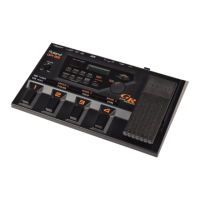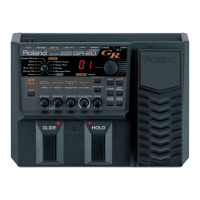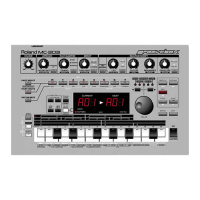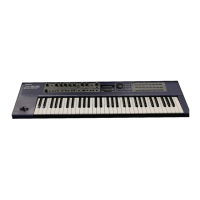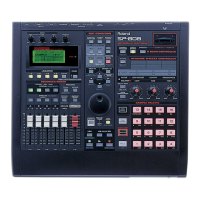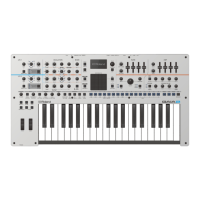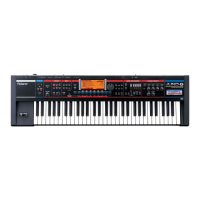You can select from the 384 sounds that are the basic
material for patches, choosing a “1st tone” (first tone)
and a “2nd tone” (second tone). Following the
sequence below, let’s actually select some tones and
assemble a patch tone.
➼
When trying out the sequence to make a patch, please
first call up the factory-installed patch A43, and use this
as a base for the current task. Since this patch does not
use any particularly complicated settings, it should be
easy to hear any changes to the sound when you change
each setting. (A version of the pacth which is read-only
but otherwise completely identical is located at E43. If
the contents of A43 have been changed, please use E43
as your basis.)
Selecting Tones: The Raw
Material (TONE #)
First, let’s choose the first tone of the patch.
<Example of the Procedure>
1. Select patch A43, then press [EDIT/PLAY] to enter
the Edit mode.
2. Set the EDIT TARGET dial to “1ST TONE.”
3. Set the PARAMETER SELECT dial to “A.” With
this, you have selected the first tone’s tone number
(TONE#). (In this example, “142” is indicated.)
4. Listening to the sounds as you go along, press the
[+] and [-] buttons to go up and down through the
tone numbers, and from those tone numbers 1 to
384, select a tone.
➼
See the Tone List on p. 104.
5. When you find a tone you want to use, switch the
PARAMETER SELECT dial to WRITE PATCH.
“A.4.3.” appears in the display.
6. Press both the [+] and [-] buttons simultaneously
to write the patch. “don.” (done) appears in the
display, and you are returned to the Play mode
automatically. With this, the sound you selected is
assigned to the first tone of patch A43.
➼
When saving to another patch number, before step 5,
turn the PARAMETER SELECT dial to “WRITE
TO...”, and use the [+] and [-] buttons to designate a
patch number as the destination.
To select the second tone, at step 2, set the EDIT TAR-
GET dial to 2ND TONE instead of 1ST TONE, and
select the tone in the same manner as before.
Additionally, in the TONE MIX “LAYER” setting of
patch A43, which we used in the example above, only the
first tone has been set to play. When you go ahead and
actually play the second tone, change to the LAYER set-
ting using the procedure shown on p. 34.
Increasing/Decreasing
Attack Time (ATTACK)
With the ATTACK setting, you can change the
amount of time it takes for the first (and second) tones
you selected with TONE# to rise to their highest vol-
umes. Use this to control whether the tone starts with
a gentle rise, or with a sharp attack.
<Example of the Procedure for Changing the
Attack>
1. Select patch A43, which you used in selecting the
first tone in the section on tone numbers (TONE#),
then press [EDIT/PLAY] to enter Edit mode.
2. Set the EDIT TARGET dial to 1ST TONE, and the
PARAMETER SELECT dial to “B” (ATTACK).
3. The current value, ranging from -50 to 50 (“0” in
the example here), appears in the display.
4. Pressing [+] increases the value setting, and the
volume of the sound rises more slowly. Press the
[-] to decrease the value, changing the setting to
produce a fast attack, like a percussion instru-
ment’s.
➼ The width of the change you can make varies with
the selected tone.
5. When you have set a sound you like, switch the
PARAMETER SELECT dial to “WRITE PATCH?”,
and press the [+] and [-] buttons simultaneously to
wrote the patch.
➼
When saving to another patch number, before step 5,
turn the PARAMETER SELECT dial to “WRITE
TO...”, and use the [+] and [-] buttons to designate a
patch number as the destination.
32
1ST/2ND TONE
Selecting and Creating Synth Sounds

